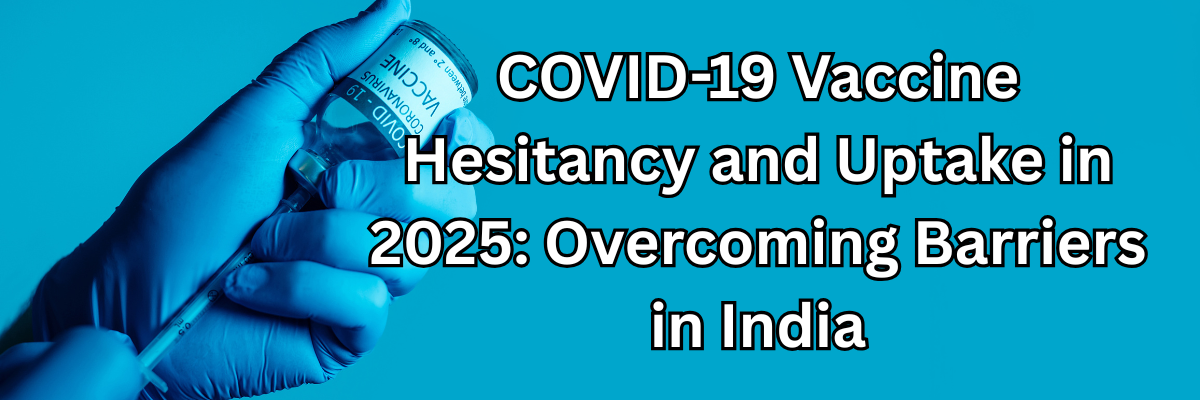
 Mrs. Mayuri Mathur
Mrs. Mayuri Mathur
COVID-19 Vaccine Hesitancy and Uptake in 2025: Overcoming Barriers in India

Globally, vaccine hesitancy differs by country and is linked to factors like religion, gender, political beliefs, and trust in science and healthcare. As per the WHO, vaccine hesitancy is shaped by context—it varies across time, place, and disease. Socioeconomic inequalities also play a role—minority groups, those with lower income or education levels, and rural populations are less likely to get vaccinated.
In India, hesitancy stems from concerns about safety, the rapid approval of COVID-19 vaccines, and a lack of long-term data. Misinformation, rumours on social media, and fear of side effects further add to the anxiety. Some also view vaccination as conflicting with religious or cultural beliefs. Questions about vaccine effectiveness against new variants, like Omicron, have also caused hesitation.
Understanding and addressing the root causes of vaccine hesitancy is essential to strengthening herd immunity and protecting vulnerable populations. The key barriers to vaccination and practical strategies that healthcare systems, communities, and individuals can adopt to overcome them are listed out as under:
1. Lack of Knowledge
One of the most common reasons for vaccine hesitancy in India is limited awareness about how vaccines work. In rural areas and even among urban populations with limited health literacy, misinformation often spreads faster than credible facts.
Strategy:
Counseling by trusted healthcare professionals—including pharmacists, Accredited Social Health Activists (ASHAs), and Anganwadi workers—can play a pivotal role. By providing clear, jargon-free explanations and busting myths, they can bridge the knowledge gap. The Ministry of Health and Family Welfare (MoHFW) and the Indian Council of Medical Research (ICMR) also offer multilingual educational resources to support such outreach efforts.
2. Fear and Misinformation
Many individuals still harbor fears related to vaccine side effects, long-term health concerns, or misinformation fueled by social media. False claims about infertility, DNA alteration, or fatal reactions continue to circulate, especially on platforms like WhatsApp.
Strategy:
Transparent, science-based communication is key. Reassurance from local doctors or health workers—people whom communities already trust—can help address emotional and psychological fears. Initiatives like the Har Ghar Dastak 2.0 campaign have successfully improved vaccine confidence by using door-to-door sensitization, especially in under-vaccinated districts.
3. Lack of Trust in the Healthcare System
In India, certain tribal, minority, and socioeconomically disadvantaged communities have historically harbored mistrust toward government healthcare initiatives, often due to past neglect or systemic disparities.
Strategy:
To build trust, it’s important to recognize these concerns rather than dismiss them. Community leaders, local influencers, and NGOs should be engaged to advocate for vaccination. Additionally, publicizing the diversity of clinical trials—including participation of different age groups, genders, and communities—can reassure people about vaccine safety and inclusivity.
4. Low Adherence to Booster Schedules
While primary vaccination rates are relatively high, adherence to booster dose schedules—especially second or third boosters—is significantly lower. This can be attributed to vaccine fatigue, lack of follow-up, or misconceptions about needing further doses.
Strategy:
To improve adherence, healthcare authorities are now recommending simplified schedules. India is currently rolling out single-dose nasal vaccines that are easier to administer and reduce the burden of follow-ups. Public health campaigns should emphasize the importance of boosters, especially for high-risk individuals such as the elderly and those with chronic illnesses.
5. Vaccine Accessibility
Geographical and infrastructural barriers still prevent easy access to vaccines in remote and hilly regions. Long travel distances, lack of transport, and limited healthcare facilities deter many from getting vaccinated.
Strategy:
Mobile vaccine clinics, satellite health centers, and collaboration with community pharmacies have shown great success in bridging this gap. Digital platforms like CoWIN now offer geo-targeted information on the nearest vaccination centers and real-time slot availability. Moreover, vaccines continue to be provided free of charge at government facilities, and this needs to be widely communicated.
6. Systemic and Operational Barriers
Proper vaccine storage, cold-chain maintenance, and administration space are crucial logistical challenges—especially when dealing with temperature-sensitive vaccines like mRNA-based shots.
Strategy:
Investing in decentralized cold-chain infrastructure and training healthcare workers in logistics management can ensure vaccines are stored and delivered safely. Urban local bodies and panchayats can allocate temporary vaccine booths in community halls, schools, and PHCs to ease congestion and waiting times.

Image Source: PHRP
Looking Ahead: Strengthening Public Confidence
Building and maintaining vaccine confidence is not a one-time effort. It requires sustained public education, community engagement, and policy support. India’s success in early COVID-19 vaccine development and deployment was remarkable. Going forward, a more nuanced, culturally sensitive approach is essential to ensure no one is left behind.
Vaccination is not just a scientific intervention; it’s a social contract—one that requires trust, access, and consistent communication. By addressing hesitancy proactively and compassionately, India can continue to lead as a global example in pandemic resilience and public health equity.
References:
Dhalaria, P.; Arora, H.; Singh, A.K.; Mathur, M.; S., A.K. COVID-19 Vaccine Hesitancy and Vaccination Coverage in India: An Exploratory Analysis. Vaccines 2022, 10, 739. https://doi.org/10.3390/vaccines10050739
MoHFW (2025). National COVID-19 Vaccination Dashboard
WHO. (2023). COVID-19 Vaccine Acceptance and Uptake. World Health Organization.
Nawas GT, Zeidan RS, Edwards CA, El-Desoky RH. Barriers to COVID-19 Vaccines and Strategies to Improve Acceptability and Uptake. J Pharm Pract. 2023 Aug;36(4):900-904. doi: 10.1177/08971900221081621. Epub 2022 Apr 23. PMID: 35465688; PMCID: PMC9047593.
ICMR Bulletin. (2024). COVID-19 Variant Surveillance and Booster Recommendations.
PIB India. (2022-2025). Press Releases on Har Ghar Dastak and Vaccination Campaigns.
CoWIN Portal. (2025). Vaccine Statistics and Booster Campaign Guidelines.

Mrs. Mayuri Mathur
Mrs. Mayuri Mathur is a Senior Medical Writer (Patient education and digital) and seasoned content creator with a rich tapestry of expertise spanning over ten years. With a diverse background in content creation, she brings a wealth of experience to the table, from crafting insightful medical articles to developing comprehensive patient education materials, dynamic press releases, and captivating brochures and website content. Throughout her illustrious career, she has demonstrated an exceptional knack for distilling complex medical concepts into easily understandable content, making her a trusted resource for both professionals and lay audiences alike. Her meticulous attention to detail and innate creativity have enabled her to deliver content that not only informs but also engages and inspires. Whether elucidating intricate medical procedures or crafting compelling marketing materials, her versatility and dedication shine through in every project she undertakes. Her passion for writing, coupled with her profound understanding, makes her an invaluable asset to any team or project. In a constantly evolving digital landscape, where effective communication is paramount, Mrs. Mayuri Mathur stands out as a beacon of excellence, consistently delivering top-notch content that resonates with audiences across diverse platforms.

.png)
.png)
.png)






Please login to comment on this article